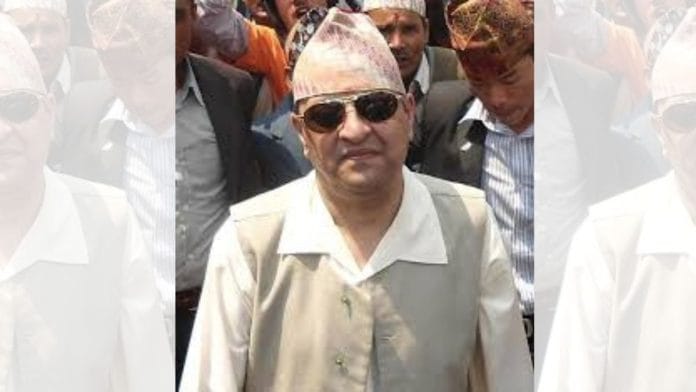New Delhi: Nepal’s former King Gyanendra Shah, who was ousted from power 19 years ago after large-scale protests against his authoritarian tactics, was Sunday greeted by crowds in Kathmandu, calling for the reinstatement of his abolished monarchy and the restoration of Hinduism as a state religion.
An estimated 10,000 people crowded the streets outside Kathmandu International Airport as Shah landed in the city in a chartered jet after spending two months away in Pokhara. “Vacate the royal palace for the king. Come back, king. Save the country,” chanted the crowds. “Long live our beloved king. We want the monarchy.”
Reports suggest that top members and workers of the Rastriya Prajatantra Party (RPP) largely formed the crowd. Founded in the 1990s by allies of the monarchy, the RPP is now leading the call for restoring the monarchy. RPP currently has 14 out of 275 seats in the parliament, up from a single seat in the previous election. The next Nepalese election is in 2027.
Hundreds of security personnel controlled the crowd as Shah waved at the crowds through the sunroof of his car, which took nearly two-and-a-half hours to snake through the crowded 5km route to his private residence from the Kathmandu airport.
Enthusiastic supporters cheered him on, calling for the return of the monarchy and the downfall of current Nepal Prime Minister K.P. Oli’s government.
The PM, meanwhile, has challenged Shah to launch his own political party and win an election.
“The Constitution does not recognise the monarchy, and if he is keen to get into power, he should contest election… the monarchy was thrown by the people long ago, and getting somebody back on the throne is impossible,” said Oli.
Analysts say that “this turn towards the monarchy” in Nepal politics represents the deep dissatisfaction against a slew of corrupt governments and a yearning to return to the past before the monarchy was abolished formally in 2008, following a people’s movement.
Shah seized absolute power in 2005, assuming an authoritarian role, until street protests in 2006 forced him to hand power over to a multi-party government. The multi-party government ultimately voted to abolish the 240-year-old Hindu monarchy in Nepal in 2008.
Since then, Nepal has had 13 governments in 16 years, and many are now calling for another change.
“This is a clear disapproval of the current regime and how political parties have conducted themselves,” said commentator Yubaraj Ghimire. “I do not know if we should infer a return to the monarchy—it is difficult to predict now.”
Also read: How Nepal ‘evolved as a sullen neighbour when it should be the friendliest of all’
A potential comeback
Shah has had a chequered history as head of state. He was crowned in 2001 after his elder brother, King Birendra Shah and his family were killed in a mass murder, wiping out the royal family.
Till 2005, he ruled as constitutional head of state before announcing that he had assumed executive and political power to fight the Maoists. He dissolved the parliament, declaring a state of emergency and bringing in the army to rule the country and arrest politicians and journalists. His actions triggered mass protests, cutting short his reign in 2006.
The subsequent government signed a peace deal with the Maoists, after which the civil war ended.
However, the abolition of the monarch in 2008—without democratic support—became a crucial moment in that radical phase of Nepal politics, said Ghimire, adding that the events sowed seeds of resentment that seemed to be sprouting today.
“This is a historical issue coming up for talks in ongoing politics from 2008 when the monarchy. After remaining two years in suspension, there was resentment among the moderates, who wanted norms and traditions of politics followed. It was a crucial decision that the people were not involved in,” said Ghimire.
“Since then, there had been some hope that political leaders and new powers would promote democracy. However, in the 18 years that have followed, corruption has been very rampant, and rulers, literally, have put themselves above the law,” he added.
What’s more—Shah did not leave the country despite being dethroned. He stayed in Nepal.
On 18 February this year, on the eve of Nepal’s National Democracy Day, Shah gave a speech urging Nepalis to unite for “the defence, progress and prosperity of the country,” issuing an appeal to the country to move towards a “path of progress.”
“Politics that adopt a prohibitive approach does not strengthen democracy,” he said. “The arrogance, personal interests and dogmatism of the parties and the opposition cannot make democracy dynamic.”
He then travelled to various parts of the country, visiting temples and making speeches, and began to receive rousing receptions.
The culmination was yesterday, said Ghimire. “He (Shah) received a massive welcome at the airport when he returned to Kathmandu, bigger than, perhaps, either he or the government anticipated.”
An editorial in The Kathmandu Post has cautioned against magnifying the popularity of the deposed monarchy.
Yet it would be an exaggeration to say that most Nepalis back the restoration of the institution, as the monarchists claim.
In a democracy, the best measure of the popularity of a political party or a political ideology is the support it gets at the ballot box,” the editorial says, pointing out that the RPP is by no means a political heavyweight yet.
The challenge to the monarchists has also been offset by trouble within the parliament, as the Maoists—led by former prime minister Pushpa Kamal Dahal Prachanda—have been protesting against alleged corruption by Oli and his government.
(Edited by Madhurita Goswami)
Also Read: India doesn’t need to sweat over Oli’s China drift—Nepal knows the limits







Indian neighbour are beggars. Again and again this is proved. If we have congress then india will also be beggar